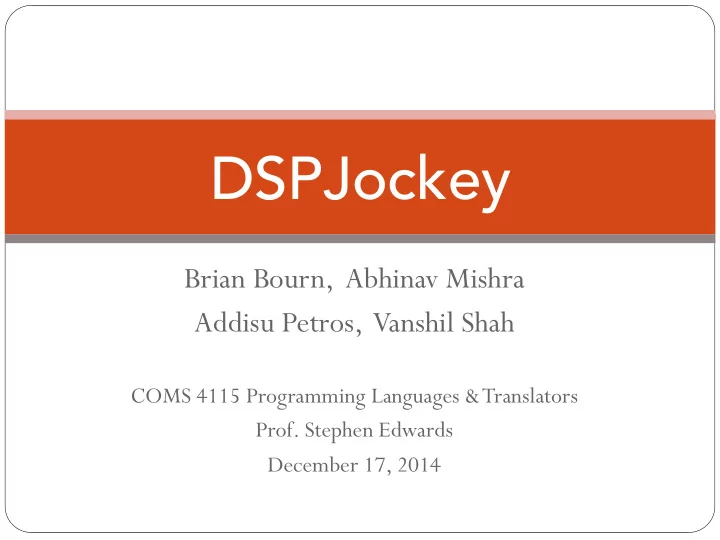

DSPJockey Brian Bourn, Abhinav Mishra Addisu Petros, Vanshil Shah COMS 4115 Programming Languages & Translators Prof. Stephen Edwards December 17, 2014
Motivation • Digital Signal Processing used in fields of Electrical Engineering, Audio mixing, and even algorithmic trading • Many useful operations that can be done in signal processing such as convolution, filtering, time shifting • Lack of tools to build and manipulate signals easily • Notion of global time for a signal only apparent in languages that model hardware such as SystemC
Why DSPJockey? • Provides a simple framework for creating and manipulating signals using Signal data type • C-like syntax including primitive data types • Includes built in functions common in DSP • Global time for each signal: easy to access signal at current time or at a previous time (past)
Language Tutorial • DSPJockey uses C/C++ like syntax • Includes the primitive data types, int, float, string, and bool • Aggregate data types are Array and Signal • Functions must have a return type
Array Arrays are similar to C as they are lists that are of a fixed size and contain float values. To create and initialize the array of a given size, say 10 let arr = Array[10]; To access the third element in this array float x = arr[2];
Signal Signals are similar to arrays are implemented as a circular buffer and its values are accessed by using the time keyword. To create a signal: let sig = new Signal[]; To access the value of signal at current time: float y = sig[time]; The value at a previous time can be accessed by subtracting the number of time units from time: If we want to access the value at 2 time units before current time float z = sig[time-2];
Signal (cont’d) When an operation is performed on a signal, it is done over the whole signal. Example: sig[time] = sig[time] +1 will increment all the samples in the signal by one.
Control Flow If/else, while and for loops follow the same exact syntax as C. • If/else statements are exactly similar to C and the else statement is not required. • if ( boolean_condition ) { } else { } While loop: • while ( boolean_condition ) { } For loops : • for(initialization; boolean_condition; iteration_step){ }
Functions Functions are similar to C/C++ but there are two types of • functions, 1. normal functions, return a primitive type • int x(args){ • } 2. stream functions used for manipulating signals • stream x(args){ } Every single .dj file must contain a main function. • Calling a function is done in the same way as C/C++ • int result = function(float a);
Built-in Functions The print is just used for printing to standard output • print “hello world”; print 5; The Sum function takes in a id, starting index, ending index • and expression and evaluates the summation sum x = 1 to 2:x+1;//5 •
Language Implementation
Lessons Learned • Start on time! • Understand components of compiler before beginning • Develop in smaller chunks • Learn Ocaml before or right at the beginning of the course • Think about how all the components connect so that you don’t have to end up going back to previous sections
DEMO!!!
Any Questions???
Recommend
More recommend